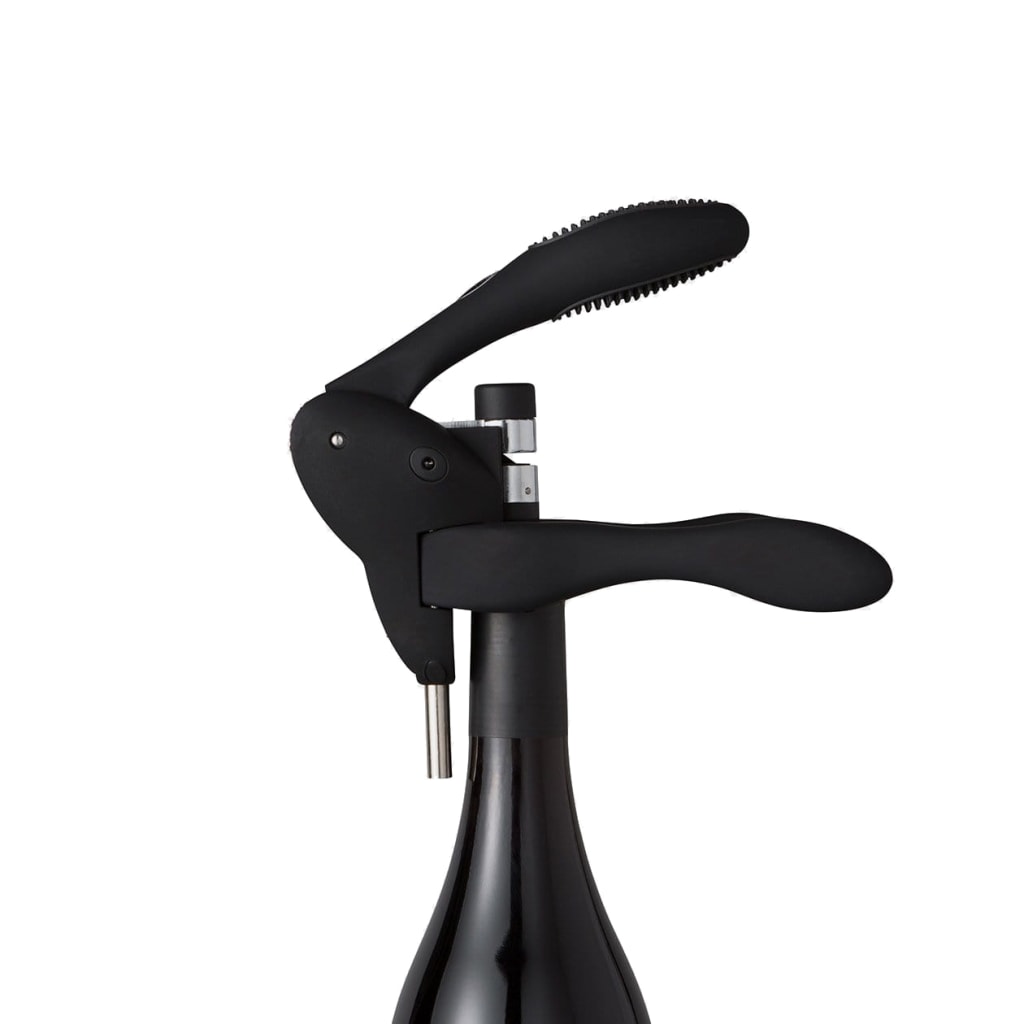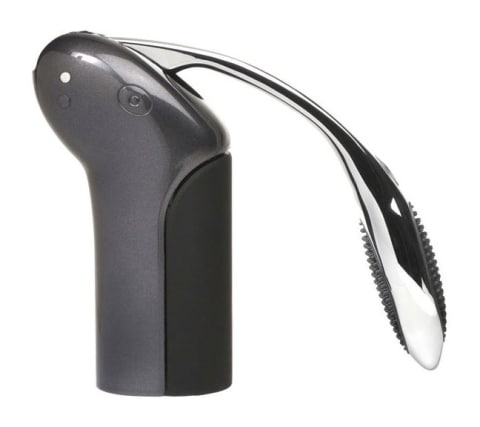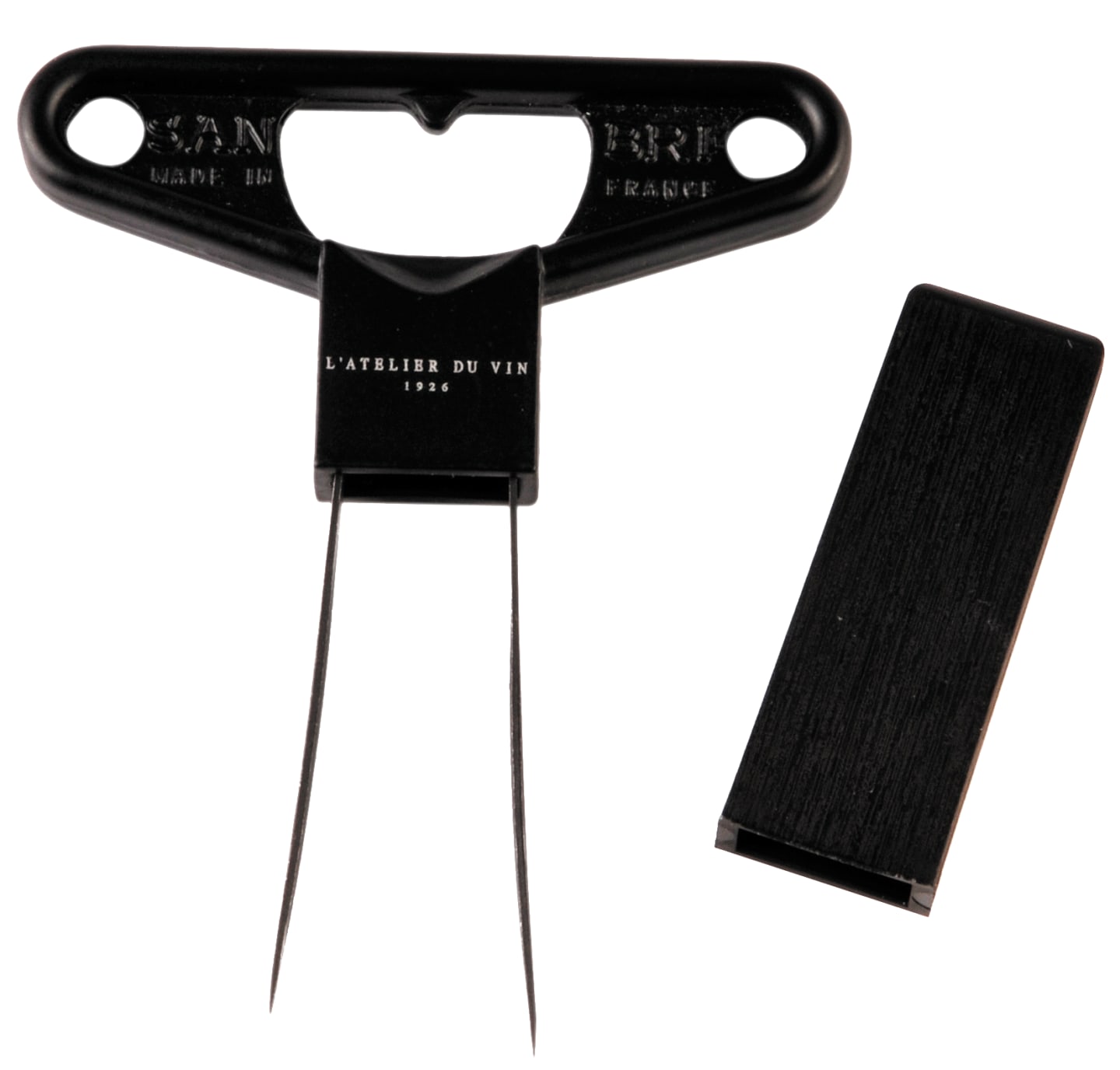A corkscrew is a device to open bottles sealed with a cork, such as wine bottles. They can be manual or electric. Most models feature a twisted metal rod that the user drives into the cork to fit it and pull it out.
Corkscrews come in numerous variations. They differ in size, usability, the necessary level of strength and manual skill, and price. Let us discuss the most common types of corkscrews:
SIMPLE CORKSCREW
The most basic corkscrew consists of only two elements: A twisted metal rod with a sharp head (often called “worm”) and a handle attached to it at a right angle.
Typically, the handle is wooden, but you might also find models with plastic or metal handles.
The simple corkscrew requires a lot of physical strength and manual skills. Here is how to use it:
- First, use the sharp tip to cut the foil and remove it.
- Grab the bottleneck firmly.
- Slide the sharp end of the worm into the middle of the cork. Don’t go too deep. A few millimeters are enough.
- Next, twist the corkscrew into the cork slowly. Make sure it does not slip away.
- Stop when about one full turn is left. The head should not go entirely through the cork. Otherwise, pieces could break off and fall into the wine.
- Now, pull the cork carefully out of the bottle.

Simple Corkscrew

Self-Standing Winged Corkscrew
$26.99
from: Wine.com
ADVANCED CORKSCREW
Advanced corkscrews function similarly to the simple models, but they are easier to handle. A plastic body frames the metal worm with the handle. When placed on the bottleneck, this body holds the corkscrew in place stably and ensures that the worm points to the’s center.
Besides the increased stability, advanced corkscrews have another big advantage: They require much less physical strength. That is how you use it correctly:
- Remove the foil from the cork.
- Place the corkscrew’s body on top of the bottleneck. Use one hand to hold it.
- Now start twisting the handle. If you have placed the device properly on the bottle, the worm will slide precisely in the middle of the cork.
- When the metal rod is completely inside the cork, keep twisting. It might be a little harder than before, but the worm will pull the cork out when you twist constantly.
BUTTERFLY CORKSCREW
With a body that frames the bottleneck, the butterfly corkscrew (or winged corkscrew) looks similar to the advanced corkscrew. There is one important distinction, though: It has two levers. Via a simple mechanism, these wings are connected to the worm. And when you start twisting, they will move up.
Usually, butterfly corkscrews are made from stainless steel. Some models might have rubber inlays on the bottom part to avoid accidentally shattering the bottleneck, or the levers for better handling.
The winged corkscrew requires more physical strength than the advanced corkscrew, but a lot less than the simple models. These are the single steps:
- Remove the foil from the bottleneck.
- Set the corkscrew on top of the bottle. As it will not be as stable as an advanced corkscrew, you must fix it with your hand.
- Twist the handle to drive the rod into the cork.
- Stop as soon as the levers have risen up.
- Now pull the levers down. As you move them down, the cork will move out of the bottle. Make sure not to loosen your grip, so the corkscrew does not slip away.
- Typically, the cork will not come out entirely when pushing the levers. So grab the corkscrew around its body and slowly pull the cork out the rest of the way.

L’Atelier Classic Wing Corkscrew
$39.99
from: Wine.com
SOMMELIER’S KNIFE
The sommelier’s knife is known by several other names, such as “wine key” or “waiter’s corkscrew”. It is basically a foldable corkscrew and looks similar to a jackknife. But instead of a blade, it has a worm. Besides the worm, it also has a foldable lever with two notches. Typically, this level features a bottle cap opener for opening beer bottles. Many models also have a foil cutter. The handle can be made from wood, metal, or plastic. As it perfectly fits into a pocket when folded, this is the favorite bottle opener of many waiters and sommeliers.
It requires less body strength when opening a bottle, but a little more manual skill. You might need some time to master using the sommelier’s knife. Here is how to do it:
- Cut the foil with the blade or the tip of the worm. Remove it from the bottleneck.
- Place the corkscrew tip in the middle of the cork and slide it in a few millimeters deep.
- Turn the handle to drive the screw deeper into the cork.
- Place the middle notch of the lever on the rim of the bottle.
- Now, slightly pull the cork about half the way out of the bottleneck. Use your thumb to keep it in place.
- Next, place the second notch on the bottle rim and pull the cork out entirely.
SWISS ARMY KNIFE
The Swiss Army Knife is probably the most famous all-purpose tool worldwide. It was developed in the late 19th century for the Swiss army and has undergone multiple redesigns since then. Modern models are easily recognizable by their red handles and the Swiss cross. They come in numerous versions that typically contain multiple folding tools, including blades, rasps, saws, scissors, can openers, and screwdrivers. And, of course, it has a corkscrew. Like a sommelier’s knife, the Swiss Army Knife fits into your pocket, so it’s an excellent tool for travel.
But it requires some physical strength and manual skill to get a cork out of a bottle. Here is how you do it:
- Unfold one of the blades and remove the foil.
- Fold the blade back in and unfold the corkscrew.
- Grab the bottleneck firmly. Place the worm in the center of the cork and slide it in.
- Start twisting.
- When the worm is entirely inside the cork, pull the knife’s handle and get it out.

Swiss Army Knife
RABBIT CORKSCREW
A rabbit corkscrew is probably the best manual corkscrew for people who never have opened a wine bottle before. It is very easy to use and requires only very little physical strength. Unfortunately, it is also rather bulky compared to other models, so it is not a device to carry around in your pocket.

The Rabbit Rabbit Original Leverpull Corkscrew
$49.99
from: Wine.com
This type of corkscrew has three levers. Two of them work like pliers and help the user to fix the bottle opener on top of the wine bottle.
The name rabbit corkscrew comes from these levers because they look like the ears of a rabbit. Some people also call it “bunny ear corkscrew”.
When pushing down the third lever that sits on top of the device, it will drive the worm into the cork. And when moving it back up, it will pull the cork out of the bottle. Here are the details:
- First, remove the foil from the bottle.
- Pull the top lever up completely.
- Now put the corkscrew on top of the bottleneck. Fix it with the bunny ear levers, so it sits stably.
- Push the top lever all the way down to drive the metal worm into the cork.
- Move the handle back up to pull the cork out of the bottle.
LEVER CORKSCREW
The lever corkscrew is a simplified version of the rabbit corkscrew. Instead of the two bunny ears, it has just one lever that allows the user to fix the device on the bottleneck. Because of this difference, it is less bulky, while it is similarly easy to use.
Usually, the lever corkscrew is made from steel with rubber applications for a better grip. Here is how you use it:
- Cut and remove the foil from the cork.
- Put the corkscrew on top of the bottleneck. Make sure the top lever is pointing upwards.
- Grab the device with one hand and push the side lever with your thumb to fix it to the bottle.
- Push the top lever down with the other hand to drive the worm into the cork.
- Pull it back up to remove the cork from the bottle.

Vertical Rabbit Corkscrew
$49.99
from: Wine.com
TABLETOP AND MOUNTED CORKSCREWS
Stability is the deciding factor when opening a wine bottle. A lack of stability can result in broken corks or -even worse- shattering bottles. Mounted corkscrews reduce this risk. They can be attached to a wall or a counter, so they cannot slip away when opening a bottle. Other models have stands to be placed safely on a table or a counter.
Mounted corkscrews are made from steel or plastic. Some might also have wooden components, especially in the handle or the stand. Their mechanics are the same as in lever or rabbit corkscrews. Pushing down the lever on top of the device drives the worm into the cork. And moving it back up will pull the cork out of the bottle.
Mounted corkscrews are great for opening many bottles in a short time. Thus, they’re the right choice for restaurants or bars. If you drink wine or host dinner parties regularly, they might make sense for you as well. They also are very decorative in home bars. Be aware that you need some space to mount them.
To use a mounted corkscrew, follow these steps:
- First, ensure the device is attached safely to the wall or counter.
- Remove the foil from the wine bottle.
- Insert the bottleneck into the device. Make sure to hold it firmly. In case, your device has a rabbit lever, hold it safely to keep the bottle in place.
- Push the lever down so the worm can grab the cork.
- Pull it back up to its starting position to get the cork out.
ELECTRIC CORKSCREW
An electric corkscrew is even easier to use than a rabbit corkscrew because it does not require physical strength or manual skill. Once in place, the user only has to push a button, and the device opens the bottle within seconds.
Its mechanics are similar to an advanced corkscrew: The device drives the worm into the cork and keeps twisting to pull it out.
Most Electric Corkscrews are wireless. They have a battery and typically come with a recharging station. Many models also include a manual foil cutter.
As already mentioned, using an electric wine bottle opener is fairly straightforward. Here is how you do it:
- Remove the foil either with the foil-cutter or with another sharp tool.
- Hold the bottle with one hand so it can’t move away.
- Place the electric corkscrew on top of the bottleneck with your other hand. Make sure it sits straight and stably, and hold it firmly.
- Push the button to start the electric corkscrew.
- The device will move down to drive the worm into the cork. Make sure you keep holding it straight.
- Wait until the cork comes out of the bottle.
TWO-PRONG CORK PULLER
All of the corkscrews we have discussed so far work with a twisted metal rod (the worm). They require the user to twist this rod into the cork to get hold of it.

L’Atelier Bilame Twin Blade Corkscrew
$29.99
from: Wine.com
The Two-Prong Cork Puller works differently. It does not have a worm. Instead, it contains two thin metal needles attached to a handle.
The Cork Puller is the best choice for very old wines. They often have crumbly corks that might break when using a corkscrew with a worm. But with the Cork Puller, this risk is significantly lower.
On the other hand, it requires much more manual skill and significant hand strength. To use the Two-Prong Puller, follow these steps:
- Remove the foil from the wine bottle.
- Hold the wine bottle close by its neck.
- Slide the two prongs inside the bottleneck. Each prong should go between the glass rim and the cork.
- When it is entirely in, twist the Puller slightly and pull it back up. When you do it right, the prongs will catch the cork from both sides and pull it out.
AIR PUMP BOTTLE OPENER
Another bottle opener that comes without a worm is the air pump opener. Instead, it has a needle. This needle cuts through the cork until its tip is inside the bottle. Then, gas is pumped through it. Some devices have a gas cartridge for this purpose. Others require manual pumping by the user. The effect is the same in both cases: The pressure inside the bottle increases and finally forces the cork out of the bottle.
Air pumps are typically easy to use, although manual pumps require some physical strength. Bottle openers with gas cartridges have one crucial disadvantage: As the cartridges contain only a limited amount of gas, customers have to rebuy them repeatedly.
- Cut the foil from the bottle and remove it.
- Place the pump on top of the wine bottle. Make sure it sits safely and tightly.
- Pump air into the bottle. A couple of pumps should be enough to get the cork moving.
- Adjust your grip when the cork starts moving, so the bottle opener does not slip off the bottle.
- Keep pumping until the bottle is open.

Air Pump Bottle Opener
CORAVIN PRESERVATION SYSTEM

CORAVIN Pivot
$99.00
from: Coravin.com
Strictly speaking, the Coravin Preservation System is not a bottle opener because it doesn’t remove the cork from the bottle. Instead, it injects a needle through the cork into the wine. When activated, it pumps a bit of gas into the bottle and creates overpressure inside. This overpressure forces the wine out of the bottle through the needle. The system guides this wine to a tap from where the user can pour it into a glass. After using it, the device reseals the cork, so it’s possible to store the rest of the wine for months or even years.
With prices between 200 and 800 USD (depending on the exact model and package), the Coravin Preservation System is the most expensive device to open a wine bottle. Besides, it works with gas capsules. And each capsule allows you to pour about 15 to 20 glasses of wine. So if you enjoy wine regularly, rebuying capsules will increase the costs even further.
Here is how to use the system:
- Remove the foil from the bottleneck.
- Place the Coravin system on top of the bottle.
- Pull the handle on top of the device down, so the needle drives through the cork.
- Grab the bottle with one hand and the device with the other one.
- Pour the wine into the glass while pressing the trigger on top of the device.
FINAL WORDS
There are many tools to open a wine bottle. Which one is right for you depends on your personal preferences, hand strength, manual skills, and the price you are willing to pay. It makes sense to have at least two corkscrews in the house, so you always have a back-up.






